Avant-Garde Women: Review of the novel “Branded” by founding Dadaist Emmy Hennings
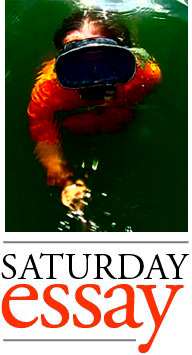 Contents
Contents
-Introduction
-The Key to Dada
-Hennings on Language
-Hennings and Expressionism
-Hennings as a Burroughsian Beat
-Technology in Branded
-The Branded Playlist
Introduction
Just last year I pointedly wondered why the books of founding Dadaist Emmy Hennings remain untranslated into English after more than 100 years. I threatened to translate them myself even though I don’t know German. Thankfully, I caught wind of a forthcoming English edition of Hennings’ autobiographical novel, Branded (edited and translated by Katharine Rout). Since I demanded translations and one appeared, now I demand this book become a film. It is Hennings’ origin story, the often hilarious tale of a proto-Dadaist navigating contradiction, absurdity, and lies.
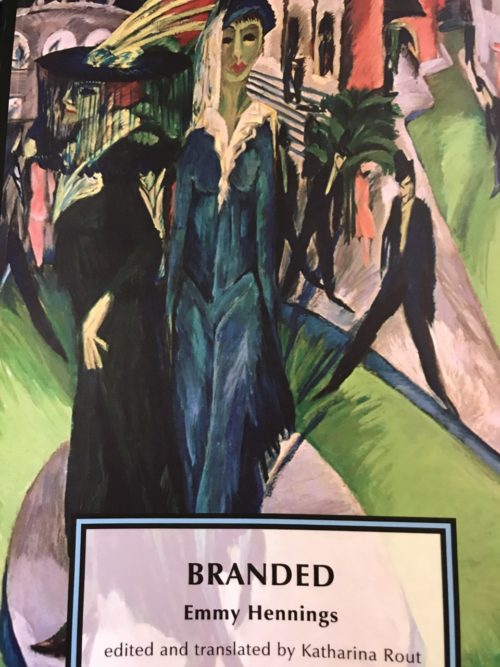
Cover art is “Potsdamer Platz, Berlin,” 1914, by Ernst Ludwig Kirchner, one of his series on streetwalkers.
Hennings is one of the most enigmatic figures in art history. Without her, the fascinating movement of Dadaism would not have had its home, its mother, and its star performer. For decades male art historians defined Dada as whatever the male Dadaists did, minimizing Dada women into the background. That is being corrected as it should be. The Germans have a 30-year head start on us, ever since they “rediscovered” Hennings in the 1990s (from Rout’s introduction, p. 7). Geared toward an academic market with a generous 30-page introduction and helpful footnotes, may Rout’s translation spark a new generation of scholarship and research. Its publication feels like an event.
I approached this book with one burning question: What light would it shed on Hennings’ relationship to Dadaism? Subjected to a century of misunderstanding and downplaying, this is Hennings in her own words. Even with its lightly fictionalized gloss, this intensely personal narrative offers the most complete picture of her thinking available. Answering the question of who she was sheds crucial light on Dada’s origins.
The book also answers the lingering question (mysterious in the English-speaking world until now) of how the mother of Dada became a Catholic mystic. I hoped Branded would illuminate this and I was not disappointed.
Published in 1920, this is the story of Hennings’ life from 1908-1910. That was a few hyperinflationary years before World War I (1914-1918) and Dadaism (founded 1916), but all the seeds are there. In her introduction, Rout mentions Branded leaves some stuff out of Hennings’ life story, but then points to Behrmann’s work establishing “that the novel follows the chronology of Hennings’ life quite closely” (p. 10).
The book is a 200-page stream of consciousness in three acts, with no traditional chapter breaks. It was experimental in its time, “shatter[ing] the novelistic conventions of plot and character development” (p. 7), and it remains experimental now. Hennings’ alter-ego Dagny — a name Hennings adopted in real life — blurs the distinction between the author and the character. I assent to Hennings’ postmodern conceit that she and Dagny are the same person.
The book opens with Hennings, starving and homeless, engaging in survival prostitution in the cafés and cabarets. Trying to work it out with God, she walks across Germany sleeping in parks and turning tricks for a sandwich. Rout mentions some academic analyses of the book as a spiritual journey from sin to redemption (p. 27), but this strikes me as the most boring possible view. Branded made me think of Ulysses, Naked Lunch, and Apocalypse Now in its hallucinatory drift through scenes of desperation and oppressive forces, leavened with gallows humor. The book unequivocally places Hennings at the center of Dada’s complex of ideas. Because it was written after Dada about her pre-Dada days, the text both anticipates Dadaism and contains it. It’s a prequel, and practically an unrecognized Dada manifesto.
The Key to Dada
Among the founding Dadaists, Hennings and husband Hugo Ball got religion. Hennings got it before she was a Dadaist; Ball got it literally onstage at a Dada event that triggered his lapsed Catholicism (see “Hennings on Language” below). Branded clarifies what Ball’s diary Flight out of Time showed, which is that the couple explored their faith in a lifelong journey that came before Dada, went through Dada, and carried on after Dada. It is not a question of “Why did they turn to faith afterward?” The question is: “How did Dada arise from these two people of faith?” After all, the irreverent and scandalous Dada could not pose a greater contrast to churchgoing seekers of the Lord. Or could it? Ball’s diary (translated many decades ago despite being somewhat impenetrable) showed how it was possible, the Dadaist in him wrestling with his own ponderous analyses of religious texts. Now this edition of Hennings’ novel brings her struggle electrically alive. One sees organically how Dada was one aspect of her search, and mysticism another. But they were the same search.
The key to Dada is the nihilism Hennings expresses in Branded. If her struggle with faith was as bad as it appears before WWI, the reader is left to infer just how bad it got once the apocalyptic war started and Dada began. The fact her faith survived is a miracle. Branded demonstrates to me her quest to understand the world engendered Dada in the first place. Hennings was uniquely situated to found, pursue, and/or shape Dadaism. She went through it and came out the other side a person of faith because her whole life was that quest. This does not make her the least of the Dadaists, as whispered over the past hundred years. Branded argues that faith, like Dadaism, is a valid response to the end of the world, and that they can coexist in the same person: “You can have different dreams simultaneously” (p. 57). Simultaneity is itself a Dada quality, yet being a Dadaist-with-faith became Hennings’ heresy, even as Ball got a pass.
Branded shows Hennings intensely concerned with Dadaist themes developed on her own, before Dada started and before she met Ball. A cynic might argue she has retroactively placed Dadaist ideas into her backstory here to strengthen some fantasy claim to being Dada’s central figure. To the contrary, she spent years extolling Ball, and never claimed centrality to Dada. But in Branded, she shows it.
Consider for a moment how her reputation somehow got it baked in that she wasn’t a real or a pure Dadaist, because she was too Expressionist or too religious. There is not in fact a purity test any Dadaist could pass. Plenty of non-Dada art and writing made it into Dada publications and performances. They were nutty for anything modern or avant-garde. Cubism and Futurism shared Dada with Expressionism and sheer abstraction in a multimedia art orgy. The purity concern developed after the fact and is fiction. The Dadaists didn’t even invent sound poetry, although Ball claimed it; if anything it may be attributed to Else Lasker-Schüler, who “was presenting her nonsense sound poetry in Berlin cabarets, poems that would be used a few years later by the Zurich Dadaists in the Cabaret Voltaire (Baroness Elsa: Gender, Dada, and Everyday Modernity by Irene Gammel, 2003, p. 147).” So the men performed cover songs of nonsense poetry, but Hennings isn’t pure enough? This idea of the male Dadaists’ great philosophical purity cemented because they all wrote manifestos. The other founding woman in Dada, Sophie Taeuber, flat-out ridiculed the flurry of manifestos. Perhaps Hennings felt the same way.
But Hennings did write Branded, which juggles all the classic Dada themes and tools: nihilism, paradox, language and meaning, shocking content, irony, and savage attacks on the status quo. Her faith does not bar her from these ideas. Did anyone ever suggest Van Gogh wasn’t a real Post-Impressionist because he was a Protestant? The only possible argument that Branded is not a Dadaist book is, what, that she didn’t write it by picking words from a hat? The fact that it was experimental in form counted for nothing? I agree with German scholar Nicola Behrmann that Hennings may be the most Dada of all. From Rout’s introduction:
Behrmann examines the avantgarde through the lens of gender and sees deliberate rather than accidental exclusion at work. Behrmann judges the supposedly marginal role and limited contributions of women to Dada as integral to Dada’s historiographical myth, created and upheld by Dada’s ‘bachelor machine’ (in reference to one of Marcel Duchamp’s installations of 1915-23) […] For Behrmann, Hennings was instead the center of the Dada movement, simultaneously unheard-of, denied, and scandalous, the ‘bachelor machine’s’ bride who co-created the literature of the avantgarde with its rejection of representation, and who herself represented nothing. In the story of Dada, Hennings inhabits its blind spot, but to Behrmann, Hennings was Dada. (pp. 13-14)
Among Branded’s many lines and scenes relating to Dadaism, one finds the following:
If I play The Orphan of Lowood in front of simple country folk, they bring me a loaf of bread and a speckwurst sausage backstage after the first act. And sometimes in small villages, the villain must secretly flee through the backdoor behind the cloakroom or else would be torn to pieces. Then art has come alive and has successfully become what it’s meant to be. I have never seen the spirit of a great piece of art move a big-city audience to the point where they would actually do something. If the audience claps, it’s the ultimate proof they lack any understanding of art. A person who is utterly stricken does not applaud. When great awe enters one’s bloodstream and before it can trigger an action, there is a sacred stillness. (p. 181)
This idea of art coming alive at the edge of awe could very well refer directly to the Dada performances at the Cabaret Voltaire, with its mad interactive crowd. Dada hasn’t happened yet in-story, so Hennings/Dagny says she has “never seen the spirit of a great piece of art move a big-city audience to the point where they would actually do something”. As the author, Hennings knows Hennings/Dagny will see that in a few years, in Zurich, after founding the Voltaire. Dadaist Hans Arp famously described Dada audiences: “Total pandemonium. The people around us are shouting, laughing, and gesticulating.” In Hennings’ parlance, they are utterly stricken, the great awe entering their bloodstream. The sacred stillness of blown minds triggered the actions of pandemonium. No one was clapping because they were too alive to sit there and clap. Hennings is defining total artistic success as what Dada accomplished on stage, what she accomplished on stage at the Voltaire: the production of peak, ecstatic states, in the service of turning life into art, and art into life.
More quotes showing her vital facility with Dadaist concerns, ideas, and attitudes:
“Facts, as the world’s visible acts are called, have become irrelevant.” (p. 38)
“Nothing happened for good reason. My trip from Munster to Cologne happened for no good reason. Still, I went. I had suddenly lost all reason. Suddenly? Isn’t it irrelevant where I am? I’ve no more reason to be in Cologne than in Munster. Even less, really.” (p. 38)
“The ad is demanding opposites. In my mind I try to reconcile the apparently irreconcilable, but fifteen minutes later I grasp there’s no opposites.” (p. 46)
“I’d better keep my hands off work.” (p. 46); see also “I had barely walked a few steps when my agitation vanished — as soon as I overcame the temptation to take on regular work.” (p. 150). These prefigure the Letterist-Situationist slogan circa 1952-1968, “Never work.” In 1948, after surviving two world wars, Hennings died of exhaustion at 63 from factory work in a depressed Germany.
“Weird! How dreadful the bizarre movements look if you are in no mood to dance.” (p. 55)
“People say a day has twenty-four hours. I no longer believe it. Surely a day has many more hours. I may be unable to count them, but my day has a vast number of hours.” (p. 61)
“I had come to believe I’d grasped the world’s vapidity, its nothingness, and I thought to myself, what’s there to offend me?” (p. 118)
“It’s strange when seemingly meaningless things make a deep impression.” (p. 129)
“By the way, all kings are pimps, in case you didn’t know.” (p. 131)
“[I] wonder whether I have begun to doubt everything because slowly, one after another, my beliefs have collapsed.” (p. 152)
“In the evenings I no longer believe in anything. How could I? One can’t find the joy of living in nightclubs. What a pitiful error: I thought the stage or the dais could save us, be a place where we could find, or lose, ourselves. But I’ve not been able to get rid of myself. Everything’s still there.” (p. 191)
“Danced in the Bar Riche a few evenings. I mustn’t think of death as long as I’m alive. The gentlemen in the bar view me as the most fun of all. I dance an improvised solo around the circular bar at the center of the place. A little staccato that’s come to me during the music. During the dance I juggle sweet almonds and peaches.” (pp. 205-206. That is one of two references in the book to almonds and peaches as bar food.)
“Dying is common. An unavoidable custom everyone must follow. I’m merely a child of my time, which I haven’t been able to evade. Dying is in, and I am fashionable.” (p. 208)
The following is a clear reference to WWI, which has not happened yet in-story: “Hard to imagine that everything succumbs to decomposition. At the resurrection, Saint Anthony will have his hands full gathering up the scattered limbs.” (p. 209)
This line is from a long routine where she tries to make money by selling her cadaver to science in advance: “I feel quite professional as a cadaver, which may strike you as absurd.” (p. 211)
Hennings on language
She didn’t do what the Dada men did, like make “sound poetry,” Ball’s specialty. But in Branded, Hennings explores Dadaist or Dada-adjacent ideas about the limits of language, demonstrating her bona fides. Hennings was fluent in the Dada philosophy that language had been corrupted by lies and must be negated or at least subverted. The following passage describes a surreal moment of spiritually-elevated automatic speech. The scene takes place in the quiet, empty Cologne Cathedral, where Hennings silently communes with the statue of a saint:
How insignificant words are. I actually hadn’t meant to say anything. Instead, I was waiting for something to be said to me. I was waiting for an answer, but nothing came, absolutely nothing … It was so quiet. I was the lone restlessness in a mute world. I could no longer bear it. Words that uttered themselves fell from my lips as if a vessel were overflowing and drops were falling to the ground. I heard myself speak, and my voice sounded alien, as if it weren’t mine. I heard the same sentence repeated over and over: ‘[…] it’s no longer about happiness. It’s about …’ About? What then was it about? As if I had to come to my own rescue, I tried hard to figure out what it could be about. I thought about it in the Cologne Cathedral. And I still think about it today, in the streets, at the post office, in my room, on the benches and in the waiting rooms, everywhere, everywhere. (pp. 40-41)
Hennings thought deeply about language because her central concern was meaning, that fundamentally Dadaist issue. Ball was shaken by an experience performing nonsense on a Dada stage that made him feel the shadow of the Church. Hennings and Ball recognized there was a place where language and sound poetry became an ecstatic state with “words that uttered themselves,” brushing up against glossolalia and direct connection with the divine. The language experiments of Dadaism may have strengthened their faith. Filled with international war refugees, Zurich in general and the Cabaret Voltaire in particular became a living Babel, and one of its tongues was nonsense. One’s voice could be “alien, as if it weren’t mine.”
Hennings must have immediately understood what Ball experienced, and why it spooked him: his onstage gibberish adopted the stately cadence of the priests, seemingly of its own accord. Stripping language of meaning revealed to the couple a super-meaning. Hennings writes “surely the sublime divine language is incomprehensible.” (p. 195) Their faith was the one thing remaining after Dada’s negations.
Other Hennings quotes about language:
“How imperfect language is. It would be good to make oneself known without words.” (p. 101)
“I, too, threw myself into the conversation, without, however, being able to make myself heard. And could no longer tell whether the talk was about the constable or the soul because the terms were terribly muddled.” (pp. 140-141)
“We can learn so much from nature. I so love the colorful autumn leaves on the ground. What a strange language it is that has no words yet speaks so clearly: ‘Thy will be done.’ And that is still saying too much.” (p. 149)
“My word is my soul’s statutory declaration. But has the word ever been able to express the feeling? How words pale once they have escaped the lips.” (p. 160)
“It’s indescribable how many dispensable words are said in my circle.” (p. 164)
“Behind even the most banal of phrases I sense a wide, desolate world.” (p. 217)
“My name is bandied about and is a sound wave. My name is incomprehensible, like myself.” (p. 233)
Hennings and Expressionism
A student of Expressionism could offer a different reading. But the past labeling of Branded as Expressionist leaves me cold. I’d somehow got it into my head that people called her Expressionist-as-opposed-to-Dadaist as a slur, like saying someone isn’t punk enough. But it’s not a competition between Expressionism and Dada. I read somewhere Hennings was admired by the Expressionists, in which case we might say she reached the glass ceiling in two different art movements. It only expands her repertoire.
Many revered writers have been viewed through an Expressionist lens, from Kafka to Faulkner to Hemingway. It is not a slur. Hennings is an original stylist with affinities to traditions old and new. She is not contained by any. As above, I mostly see Hennings the Dadaist in this book. But that’s what I was looking for. She’s also Hennings the Expressionist, the mystic, and the free-love feminist, complexifying the closer one looks.
Hennings as a novelist is much weightier than her delicate poetry suggests, at least from the few translated poems I’ve tracked down (as well there are a couple original poems in Branded). Her prose builds invulnerable sentence by invulnerable sentence into long passages of extraordinary power. Hennings has been traditionally depicted as waif-like, elven — I imagine her played by Marion Cotillard in a hypothetical Dada biopic. The airy aspect of her personality is on full display: she declaims her own lack of willpower as society’s ill-winds blow her around Germany, walking hundreds of miles in bad shoes. But her socially weak will is contrasted with her unstoppable search; every waking moment, the powers of her mind focus on the problem of meaning. This is not a religious book. It is a book about someone struggling with religiosity among the other profound problems of existence. Hennings has the mental heft of a philosopher. Nothing of her scantly available work prepared me for the force of this narrative. Her odyssey through a liminal underworld of cabarets and cathedrals is gripping, real, and relevant to our own terrible time.
Hennings as a Burroughsian Beat
I was delighted to find Branded’s strong similarities to the early work of William S. Burroughs, specifically Junky, in its reportage from the gutter. Like Branded, Junky also exploded its own trope with a true-life take on the down-and-out. Hennings was addicted to drugs like Burroughs; although the book doesn’t address drugs, they’re present in the shadows like the looming of World War I.
Branded is not as experimental or pornographic as Burrough’s Naked Lunch, but there are affinities. The moral stances of the books revolve around an unblinking view of humanity’s shocking reality. This is the so-called “naked lunch” when you really see what’s on the end of your fork. Ball wrote of Branded in like terms: “There is no debate here. Here is this age.” Hennings later wrote of Branded, “My book is a true eye. […] I walk the street, and my books are street books” (p. 21).
Both Hennings and Burroughs defy us to look away from what they present as carefully recorded reality. Each author invokes recording devices as a symbol of objectivity at the technological edge of culture. Burroughs became obsessed with tape recorders, while Hennings compares herself to a recording device multiple times (See “Technology in Branded” below).
Burroughs believed in a magical universe; Hennings did the same in the form of Catholic mysticism. Branded made me see each represents an understandable response to a mad world. Hennings and Burroughs both reached for a higher power from the depths of gross matter.
Hennings uses a form something like the Burroughsian “routine” in many places, i.e. surreal comic monologues as a unit of storytelling. As examples I cite her addresses to various saints like Aloysius (pp. 41-42), her Kafkaesque-Burroughsian dream sequence where “time was weighed in an office and people had time bills” (p. 61-63), her address to God (pp. 194-198), her address to a tree (pp.198-200): all are positively Burroughsian in form and tone. For instance, the following routine early in the book, where she contemplates (trigger warning) suicide while ordering food she can’t pay for. It’s dark, demented, and hilarious as the tension mounts:
What’s bad is not that I drank the coffee but that I can’t pay for it. What if everyone were to drink coffee without paying? What then? Should I attempt a fainting spell? But fainting while sitting is not very convincing […] I am so tired. And I am hungry. What if I ordered an open sandwich? I could eat it slowly and use the knife to cut my wrists, afterwards of course, once I have eaten. I have not eaten since last night. It’s rather appropriate to die, I mean, to eat. Suddenly everything seems to fit. Actually, I could order a garnished schnitzel. Indeed. Admittedly. But if I order a steak, I’d have to die irrevocably. Unfailingly […] Because with a steak, you can ask for an extra sharp knife. Then I’d be obliged to die properly. Though I’d be obliged with the measliest open sandwich. The measliest! […] Life is strange. I can’t get used to it. It’ll be good to give up everything. Steak is the perfect solution. I will die no later than seven minutes after the meal […] Everyone knows I am hungry. Alas, my disgrace will get even worse. Once I am dead, the waiter will pay my bill and his kindness will be ill rewarded. However, he is the last person I will ever hurt […] I can’t comprehend death, but that’s not necessary anyway. I’ll find out how it is. For now I am devoted to eating […] How much will the waiter have to pay after my death? […] When we lie dying, the unpaid bills we’ve so desperately tried to pay while alive become trifles, and our belief turns into the clearest realization: ‘I couldn’t have paid anyway — and now I most certainly won’t.’ […] ‘Waiter, this is my last order. You’ve had a lot of trouble with me. But it’s my last one […] And I’m about to leave. Really leave.’ […] Good Lord, isn’t a simple suicide attempt enough? It’s something. Not to be sniffed at […] How the knife frightens me. ‘Get thee hence, Satan …’ I say, and the waiter comes over. ‘Pardon?’ ‘I didn’t mean you. Sorry.’ (pp. 48-52)
Other Beat resonances occur. Hennings wears out her shoes walking city to city with God on her mind, which has a Dharma Bums quality, the “walking Zen” as Snyder tutored Kerouac in the Buddhism of the trails. As well, street criminality infuses Beat literature as it does in Branded. And various Dadaists explored “Eastern and Western mysticism” (p. 14), which not only gives Hennings some cover but provides another Dada parallel to the Beats. Branded made me think, as I do sometimes, that all artists are Beat and always have been. Its publication preceded the publication of Howl by less than 40 years, and it’s all there: Hennings is “starving hysterical naked,” an “angelheaded hipster.” For all this talk of Hennings being Expressionist, I found Branded crucial to my understanding of Dadaism, and she’s as Beat as anything else.
Both Hennings/Dada and Burroughs/the Beats prefigured punk rock. Greil Marcus argues the through-line connecting Dada and punk signifies the real history of the 20th century. The Hennings of Branded — a penniless culture-jamming anarchist struggling with nihilism and alienation — is punk as fuck. When she got on stage, all that raw energy was at her disposal. Hennings was a punk rocker trapped in the early 1900s.
Technology in Branded
The alienating sense of mechanized consumerism is one of Branded’s themes. I found this in Hennings’ examples of the high-tech of her time. Quaint by our 21st century sensibilities, they obliquely comment on, and strangely foretell, World War I’s industrialized slaughter. Hennings’ contemporary audience would have seen these examples as cutting-edge images from a fast-changing society, contrasted with that society’s impersonal treatment of its own citizens.
For instance, the chocolate vending machine (p. 43), offering a fake, capitalist reflection: “In the mirror of a chocolate vending machine I see that my arrangement of artificial wildflowers greatly embellishes the hat I wear, which is made of chiffon. I am preparing myself for the future.”
A café’s player piano (p.55) captures the grinding repetitiveness of assembly-line, cookie-cutter modernisms: “A piano is playing inside. It’s not an honest piano but a player piano. […] If you throw in a coin, a racket breaks out as if poltergeists were clattering inside. The moment they fall silent, someone runs to the piano and puts in another coin. And it starts all over. Waves of the Danube, again and again. What a din!” (See the Branded Playlist for a recording of the song.)
There are hints of the Kafkaesque (eek! Expressionism!) in a restaurant that we gradually realize is entirely automated: “We agreed to see each other more often in the automat [where serving staff have been replaced with coin-operated vending machines] …” (p. 97)
Hennings refers to herself as a recording device several times. Conflating biology with technology prefigures a cyberpunk sensibility decades ahead of Burroughs’ like concerns with image and audio:
“Every honest Kodak has to record the image as it presents itself. That Sunday, I must have been focused particularly sharply. And when the image becomes the negative, it inevitably has to reveal itself […] he must have laughed or else his laughter wouldn’t be on the film [….] This is how it stayed with me and cannot be blurred.” (p. 100) “Is nature so close-lipped? Where does it all get registered? [….] Everything is recorded in me. And everything is forever anew in me, as if the past were repeating itself over and over. The live image thus appears again and again inside me and becomes ever more alive.” (p. 159) “Am I a recording device?” (p. 218) “I just want to express my opinion, even beyond my death. […] Maybe instead of a funeral speech I could sing from a gramophone.” (p. 237)
The mere observation of “Gramophone music from open windows” (p. 105) seems innocuous to us but in 1908-1910 the gramophone was still a new and mass-marketed commodity. We know from the player piano example that Hennings viewed unmediated live performance as more “honest.” There is tension between the examples of the money-operated player piano and the “soft machine” (Burroughs’s parlance) recording device of her memory. Her memories repeat “over and over” as the player piano does, but not mechanically in a “din.” The “live image” repeats “again and again,” only “ever more alive.” In the early 21st century we fantasize about uploading our minds to the web. Hennings’ analogous, darkly ironic fantasy was to upload her voice to a gramophone so she could sing at her own funeral. Each fantasy cheats death with technology.
Disco lights from 1910 provide false light: “To complete the sultry atmosphere, a reflector plunges the dance hall into alternating light blue and deep scarlet. […] The blue light makes him look pallid. […] ‘My arms are aching to embrace you …’ Scarlet light. […] Oh, what mawkishness. The hall shimmers in the colors of the rainbow. Colorful silk dresses sparkle. The music breaks off with a final outcry. Dance, finished. Light, white. Couples dissolve” (p. 215). (See the Branded Playlist #14 for the song playing during this scene.)
But in the right setting, she thrives on artificial light: “The limelight of the stage was my sun.” (p. 242)
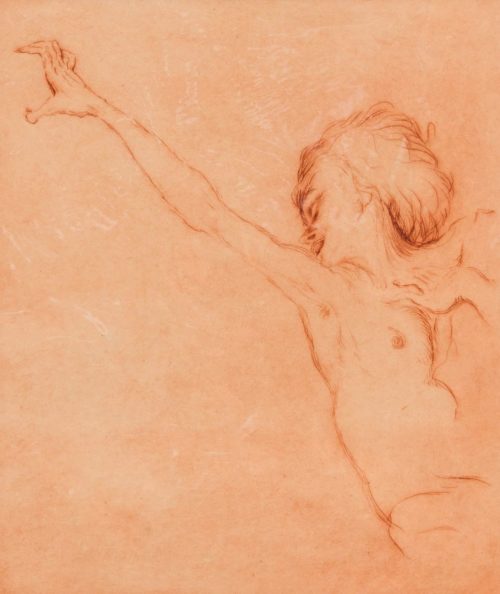
Reinhold Rudolf Junghanns, etching of Emmy Hennings.
The Branded Playlist
Branded is full of references to the music in Hennings’ milieu. Not every reference could be found by Rout, but for most she provides song name and composer in footnotes. I found many of those on YouTube and made this playlist. It is the book’s soundtrack, a slice-of-life time capsule from Emmy Hennings’ life and work.
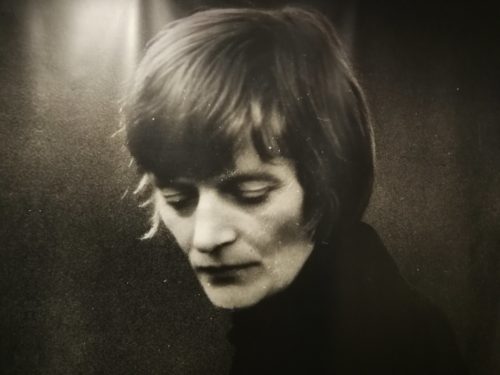
Emmy Hennings
More in my Avant-Garde Women series:
–Eliane Brau: The Invisible Icon
–The Shakespearean Tragedy of Peggy and Pegeen Guggenheim
–Michele Bernstein: Queen of the Situationists
–Sophie Taeuber: Founding Dadaist
–The Hundred-Jointed Dancer and the Laban Ladies
–Emmy Hennings: “Shining Star of the Voltaire”
An index of all Jim Richardson’s essays here.
Recommended Links:
Leave a Comment
Only registered members can post a comment , Login / Register Here



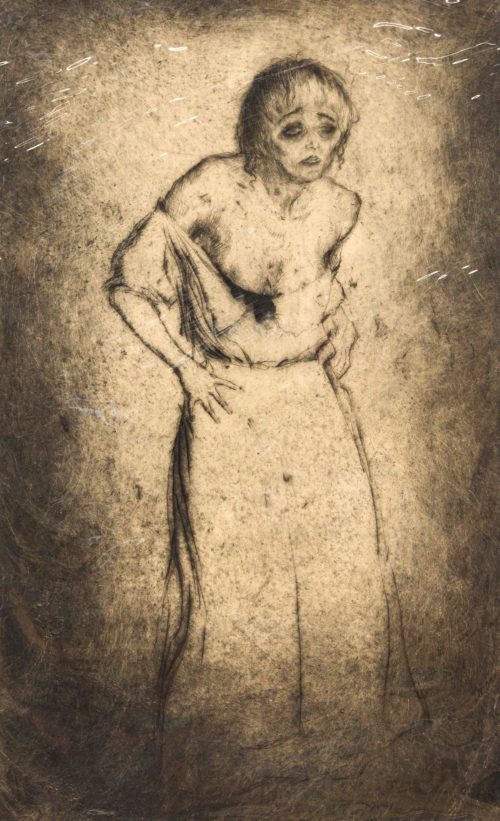
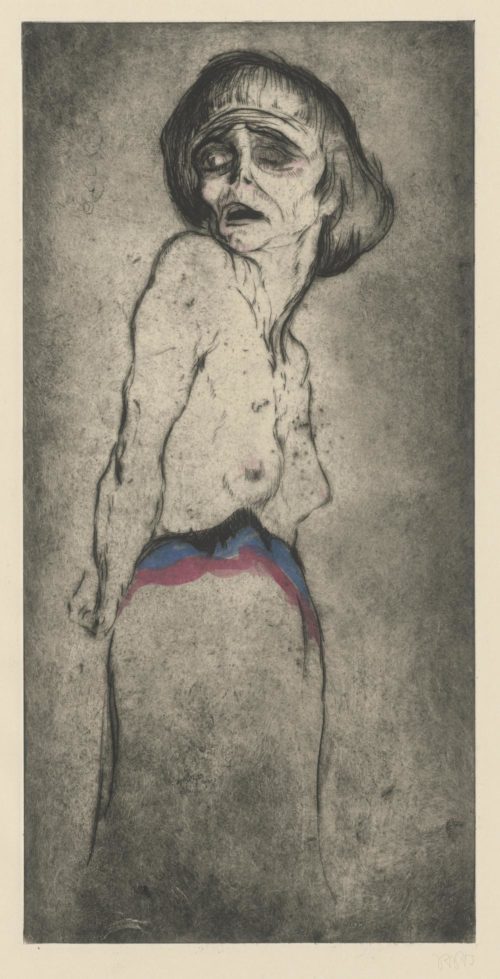
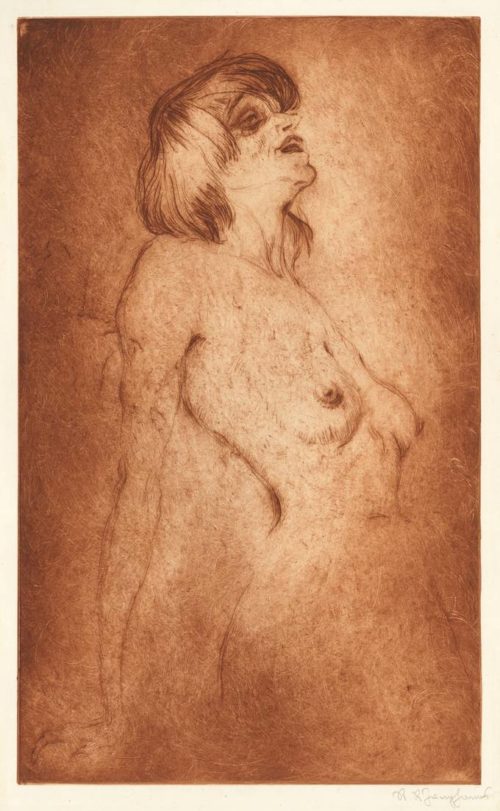
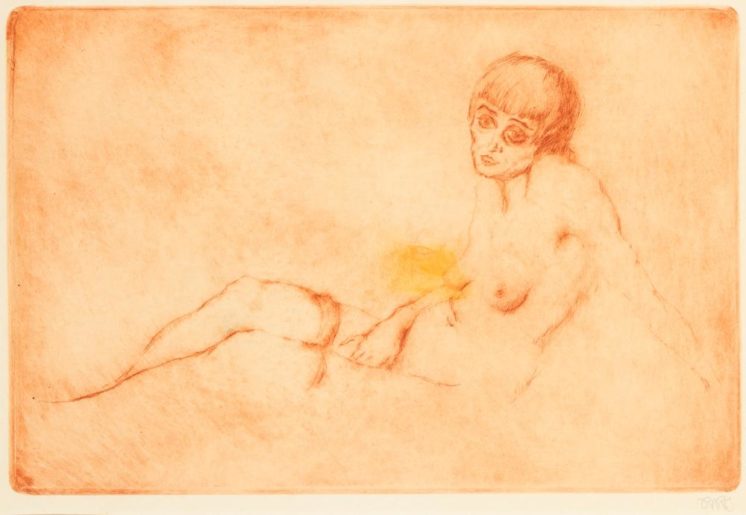












No Comments